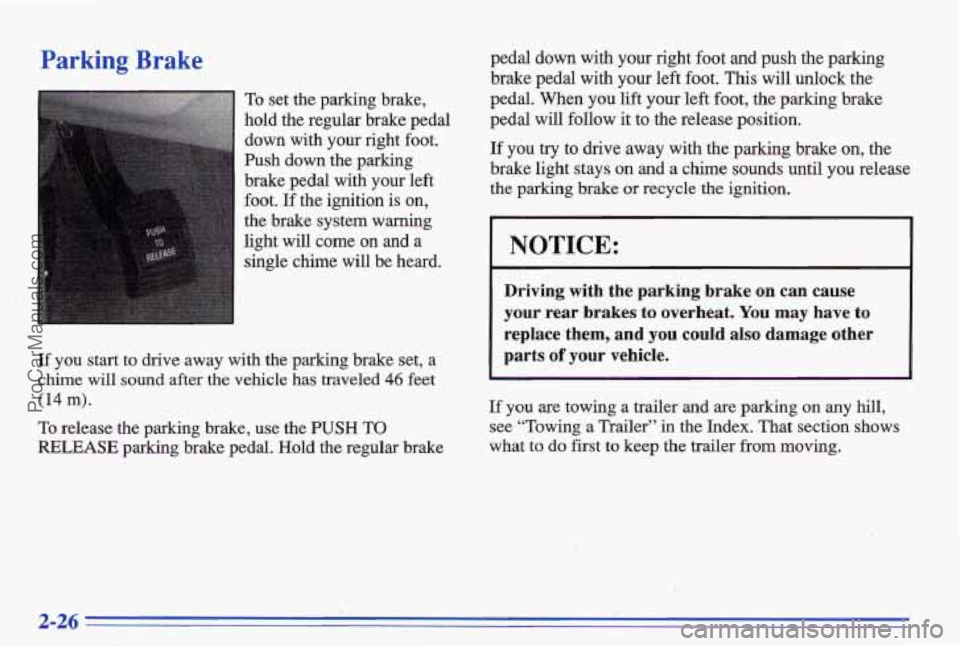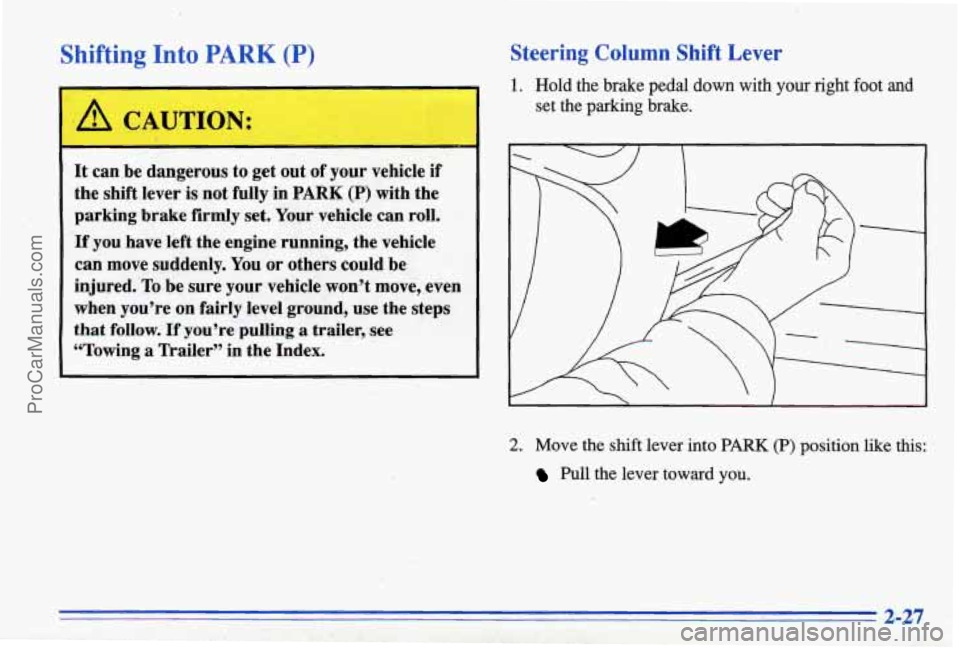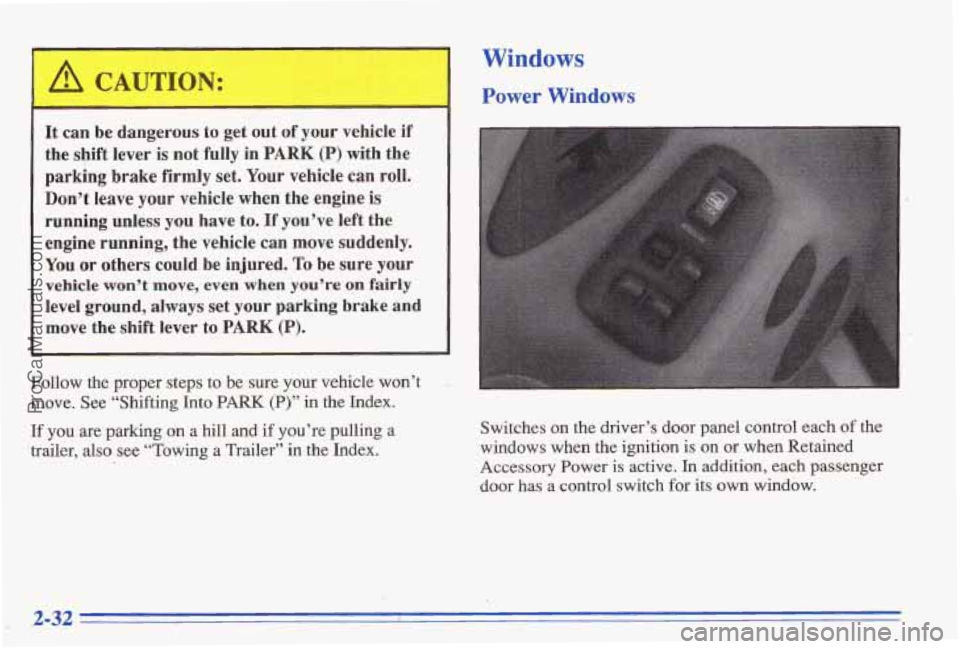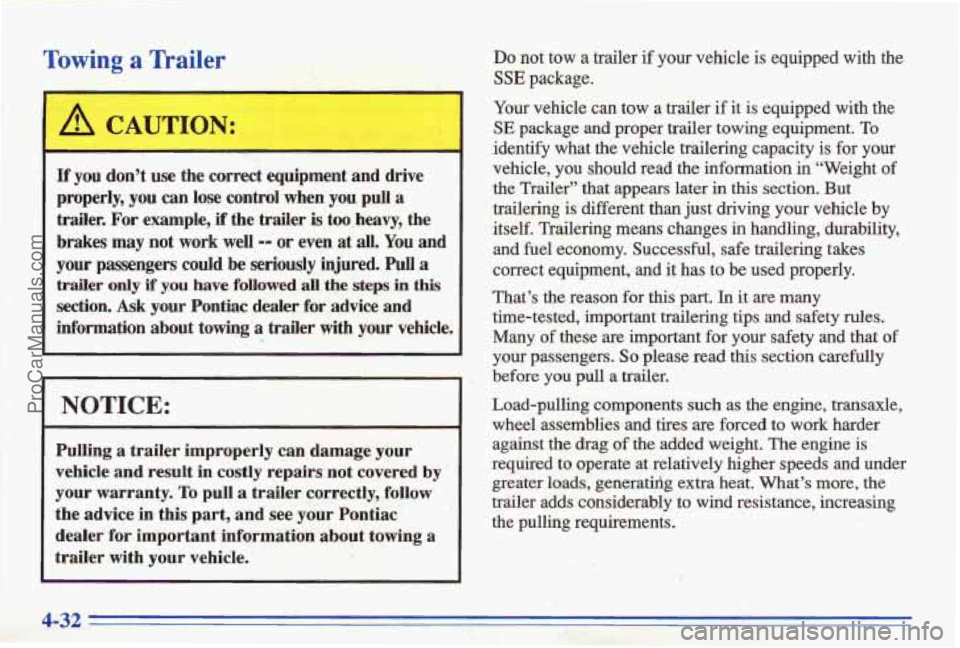1996 PONTIAC BONNEVILLE trailer
[x] Cancel search: trailerPage 67 of 387

See your Pontiac dealer or a locksmith who can service
the PASS-Key
IT to have a new key made.
If you’re ever driving- and the SECURITY light comes
on and remains on, you will be able.to restart your
engine
if you turn it off. Your PASS-Key 11 system,
however, is
not working properly and must be serviced
by your Pontiac dealer.
Your vehicle is not protected by
If you lose or damage a PASS-Key II ignition key, see
your Pontiac dealer
OT a locksmith who can service
PASS-Key 11 to have a new key made. In an emergency,
call the Pontiac Roadside Assistance Program
at
1-800-ROADSID3, or 1-800-762-3743.
. the PASS-Key II system.
New Vehicle (LBreak-In99
NOTICE:
P
Your modern Pontiac doesn’t need an elaborate
“break=in?’.But
it win perform better in the long
run if you follow these guidelines:
Dm’t drive at any one speed. -- fast or
slow
-- for the first 500 miles (804 km).
Don’t make full-throttle starts.
200 miles (322 km) or so. During this time
your new brake linings aren’t yet broken
in. Hard stops with new linings
can mean
premature wear
and earlier replacement.
Follow
this breaking-in- guideline every
time youmget new brake linings.
See ‘cTowing
a flrailer” in the Index for
more information.
Avoid making hard. stops for the first
Don’t tow a trailer during break-in.
2-16
ProCarManuals.com
Page 72 of 387

Automatic Transaxle Operation
Your automatic transaxle may have a shift lever
located on the console between the seats or on the
steering column.
There are several different positions for your shift lever.
PARK (P): This locks your front wheels. It’s the best
position to use when you start your engine because your
vehicle
can’t move easily. It
is dangerous to get out of your vehicle if the
shift lever
is not fully in PARK (P). with the
parking brake firmly set. Your vehicle can roll.
Don’t leave your vehicle when the engine
is
running unless you have to. If you have left the
engine running, the vehicle can move suddenly.
You or others could be injured.
To be sure your
vehicle won’t move, even when you’re
on fairly
level ground, always set your parking brake and
move the
shift lever to PARK (P).
See “Shifting Into PARK (P)” in the Index. If
you’re pulling
a trailer, see “Towing a Trailer” in
the Index.
2-21
ProCarManuals.com
Page 74 of 387

NOTICE:
Damage to your transaxle caused by shifting out
of
PARK (P) or NEUTRAL (N) with the engine
racing isn’t covered by your warranty.
AUTOMATIC OVERDRIVE
(D): This position is for
normal driving. If you need more power for passing,
and you’re:
- Going less than about 35 mph (56 km/h), push your
- Going about 35 mph (56 h/h) or more, push the
You’ll shift down to the next gear and have more power.
accelerator pedal about halfway down.
accelerator
all the way down.
NOTICE:
If your vehicle seems to start up rather slowly, or
if it seems not to shift gears as you
go faster,
something may be wrong with
a transaxle system
sensor.
If you drive very far that way, your
vehicle can be damaged.
So, if this happens, have
your, vehicle serviced right away. Until then,
you
can use SECOND (2) when you are driving less
than
35 mph (56 kdh) and AUTOMATIC
OVERDRIVE
(0) for higher speeds.
DRIVE (D): This position
is also used for normal
driving, however, it offers more power
and lower fuel
economy than AUTOMATIC
OVERDRIVE (@).
Here are some times you might choose DRIVE (D)
instead of AUTOMATIC OVERDRIVE (@):
- When driving on hilly, winding roads
- When towing a trailer, so there is less shifting
between gears
- When going down a steep hill
ProCarManuals.com
Page 77 of 387

Parking Brake
To set the parking brake,
hold the regular brake pedal down- with
your right foot.
Push down the
parking
brake pedal with your left .
foot. If the ignition is on,
the brake system warning
light will come on
and a
single
chime will be heard.
If you start to drive away with the parking brake set, a
chime will sound after the vehicle has traveled 46 feet
(14
m).
To release the parking brake, use the PUSH TO
RELEASE parking brake pedal. Hold the regular brake pedal down with
your right foot and push the parking
brake pedal with your left foot. This will unlock the
pedal. When you lift your left foot, the parking brake
pedal will
follow it to the release position.
If you try to drive away with the parlung brake on, the
brake light stays
on and a chime sounds until you release
the parking brake or recycle^ the ignition.
I
NOTICE:
Driving with the parking brake on can cause
your rear brakes to overheat.
You may have to
replace them, and you could also damage other
parts
of your vehicle.
If you are towing a trailer and are parking on any hill,
see “Towing a Trailer” in the Index. That section shows
what
to do first to keep the trailer from moving.
2-26
ProCarManuals.com
Page 78 of 387

Shifting Into PARK (P)
I
It can be dangerous to get out of your vehicle if
the shift lever is not fully
in PARK (P) with the
parking brake firmly set. Your vehicle can roll.
If you have left the engine running, the vehicle
can move suddenly.
You or others could be
injured.
To be sure your vehicle won’t move, even
when you’re on fairly level ground, use the steps
that follow.
If you’re pulling a trailer, see
“Towing
a Trailer” in the Index.
Steering Column Shift Lever
1. Hold the brake pedal down with your right foot and
set the parking brake.
2. Move the shift lever into PARK (P) position like this:
Pdl the lever toward you.
ProCarManuals.com
Page 83 of 387

It can be dangerous to get out of your vehicle if
the
shift lever is not fully in PARK (P) with the
parking brake
firmly set. Your vehicle can roll.
Don’t leave your vehicle when the engine
is
running unless you have to. If you’ve left the
engine running, the vehicle can move suddenly.
You or others could be injured.
To be sure your
vehicle won’t move, even when you’re an fairly
level ground, always set your parking brake and
move the
shift lever to PARK (P).
Follow the proper steps to be sure your vehicle won’t
move. See “Shifting
Into PARK (P)” in the Index.
If you are parking on a hill and if you’re pulling a
trailer, also see “Towing a Trailer” in the Index.
Windows
Power Windows
Switches on the driver’s door panel control each of the
windows when the ignition is
on or when Retained
Accessory
Power is active. In addition, each passenger
door has a control switch for its own window.
ProCarManuals.com
Page 121 of 387

If the Light Is Flashing
The following may prevent more serious damage to
your vehicle:
Reduce vehicle speed.
0 Avoid liard accelerations.
~ .I.<.’.) . .e ,,- .I - ..
L:‘:’r’ j. ,
0 If towing a trailer, reduce the amount of wgo being
hauled as soon as it is possible.
If the light stops flashing and remains on steady, see “E
the Light Is On Steady” following.
If the light continues to flash,, when it is safe to do so,
stop the vehicle. Put your vehicle in PARK (P), Turn the
key off, wait at least 10 seconds and restart the engine.
If the light remains on steady, see “If the Light Is On
Steady” following. If the light is still flashing follow the
previous steps, and drive the vehicle to your dealer or
qualified service center for service.
If the Light Is On Steady
You may be able to correct the emission system
malfunction b’y considering the following:
Did
you just put fuel into your vehicle?
If so, reinstall the fuel cap, making sure to fully install
the
cap. The diagnostic system can determine if the fuel
cap
has been left off or improperly installed. This will
allow fuel to evaporate into the atmosphere. A few
driving trips should turn the light off.
Rid you just drive through a deep puddle of water?
If so, your electrical system may be wet. The condition
will usually be corrected when the electrical system
dries out. A few driving trips should turn the light off.
ProCarManuals.com
Page 199 of 387

Towing a Trailer
If you don’t use the correct equipment and drive
properly,
you can lose control when you pull a
&der. For example, if the trder is too,heavy, the
brakes
may not work well -- or even at all. You and
your passengers could be’ seriously injured. Pull a
trailer only if you have followed all the steps in this
section. Ask your Pontiac dealer for advice and
information about towing
a trailer with your vehicle.
’ I NOTICE:
~
Pulling a trailer improperly can damage your
vehicle and result in costly repairs not covered by
your warranty.
To pull a trailer correctly, follow
the advice in this part, and see your Pontiac
dealer- for important information about towing a
trailer
with your vehicle.
Do not tow a trailer if your vehicle is equipped with the
SSE package.
Your vehicle can tow a trailer if it is equipped with the
SE package and proper trailer towing equipment. To
identify what’the vehicle ‘trailering capacity is for your
vehicle, you should read the information i.i “Weight of
the Trailer” that appears
later in this section. But
trailehg is different
than just driving your vehicle by
itself. Trailering means changes
in handling;durability,
and fuel economy. Successful, safe trailering takes
correct equipment, and it has
to be used properly.
That’s
the reason for this part. In it are many
time-tested, important trailering tips and safety rules.
Many of these are important for your safety and that of
your passengers. So please read this section carefially
before
you pull a trailer.
Load-pulling_components
such as the engine, transaxle,
wheel assemblies
and tires are forced to work harder
against
the drag of the added weight. The engine is
required to operate at relatively higher speeds and under
greater
loads, generatkig extra heat, What’s more, the
trailer adds considerably to
wind resistance, increasing
the pulling requirements, -
4-32 ‘
.. ProCarManuals.com